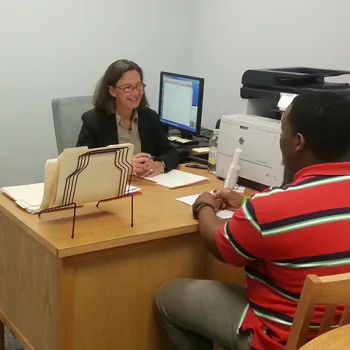When litigants come to federal court without a lawyer, they are at a disadvantage. Even if their case is strong, they can easily get lost in a maze of procedural rules and arcane terminology. A single error can doom their chances, long before a trial date is set.
In the U.S. District Court in Brooklyn, that is changing. Since late March, an innovative program has provided critical legal help to more than 150 low-income pro se litigants—people who must, usually for financial reasons, file or defend a civil lawsuit without a lawyer.
Clerk’s staff and judges in Brooklyn now refer pro se litigants to a new on-site center called the Pro Se Legal Assistance Project. There, a small legal staff from the New York City Bar Justice Center helps clients more effectively pursue their cases. The center assists with strategizing, document drafting and procedural guidance, but does not directly represent litigants in court.
“The goal of this program is to provide much needed legal assistance to our pro se community,” said Chief Judge Carol B. Amon, Eastern District of New York, at a recent ribbon-cutting. “Pro se cases represent a very significant part of our docket. The program is showing early promise of great success.”
The center’s approach, known as “limited-scope legal assistance,” can fill an important void. Most federal courts devote substantial resources to pro se litigants, such as handbooks and staff time answering process questions, and pro se staff attorneys help judges process cases. But court staff may not give legal advice to litigants, and although private lawyers offer some volunteer assistance, they cannot meet demand.
The Brooklyn center builds on a small but significant trend. Nonprofits operate similar centers in about a half-dozen federal courthouses, including three others with heavy pro se caseloads: Northern and Central Districts of California (San Francisco and Los Angeles); and the Northern District of Illinois (Chicago).
Judges and center lawyers say basic legal guidance helps the courts as well as litigants, by reducing procedural errors that bog down judges, clerks and chambers staff.
“It is very difficult to litigate a case on your own,” said Nancy Rosenbloom, a City Bar Justice Center lawyer who directs the Brooklyn program. “Often there’s a host of other issues facing our clients. Most are suffering from crises like unemployment, and the adversary almost always has legal representation. It makes it very uneven.”
A quarter of the 295,000 lawsuits filed in federal court last year were pro se, with most filed by prison inmates. The centers focus on non-prisoner pro se cases, which accounted for 8 percent of all federal lawsuits.
Pro se cases impose disproportionate strains on courts. According to a 2011 study by the Federal Judicial Center, clerks and chief judges cited excessive time demands, incomplete and illegible submissions, difficult and unstable litigants, and limited understanding of court procedure.
“Clerks’ offices and chambers … have taken many steps to reduce the burden and to help both prisoner and non-prisoner pro se litigants,” the study said. “Nonetheless, problems remain.”
Manjari Chawla, director of the Federal Pro Bono Project, which operates out of the Northern District of California, said she meets clients in 45-minute appointments, starting by reviewing the facts and paperwork, explaining the law and assessing a litigant’s best chances of success.
Clients often return at each key stage, such as responding to motions to dismiss, or preparing for discovery. In best cases, center lawyers say, litigants are able to negotiate a settlement or perform competently at trial. At the least, they better understand the process.
“Through our project, pro se litigants get legal assistance, which can include everything from answering procedural questions to drafting pleadings,” said Chawla, whose center assisted 357 clients last year. “Even if they don’t get the outcome they’re looking for, litigants walk away feeling like they had a fair shake.”
Some litigants make it to trial, and win, said Janet Lewis of the nonprofit Public Counsel, whose center in the Central District of California helped 731 clients last year. Throughout a recent four-day contract dispute trial, her staff provided nightly coaching to a client, who defeated a plaintiff’s claims for personal damages.
When new areas of litigation emerge, Lewis said, she can bolster her office’s effectiveness by consulting with participating law firms. “It’s a huge resource,” she said. “There’s no way we could be experts in all areas of the law. The support we get from law firms is invaluable.”
In Chicago, where one of the earliest courthouse pro se centers opened in 2006, Chief Judge Ruben Castillo, Northern District of Illinois, said the center has made courtroom results fairer. And properly presented cases have eased the process for everyone—litigants, court staff and judges.
“A lot of cases were stalling on the runway, and if that happens, you’re going to have a very frustrated litigant,” Castillo said. “Now we get to the fundamental merits of a case more often. It’s led to pro se litigants feeling satisfied that they’ve had their proverbial day in court.”
In the Brooklyn center’s first months, Rosenbloom has seen that appreciation firsthand. Many cases involve employment discrimination and other civil rights violations, and strategic counseling has helped several clients negotiate satisfactory settlements.
“You can see that people’s cases have been helped in a material way,” Rosenbloom said. “I’ve received a number of calls, and people have stopped by to say, ‘Thank you so much for your help, this is amazing, we’ve never had anything like this in court before.’ ”
Subscribe to News Updates
Subscribe to be notified when the news section is updated.


